Table of contents
- MOTORRAD home visit Dr. Wack A look into the S100 test laboratory
- Test procedure for the S100 white chain spray
- Further test procedures for S100 products
- Conclusion
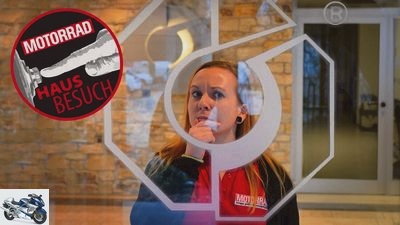
Tobias Beyl
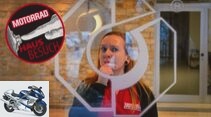
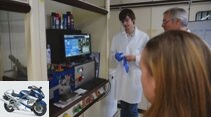

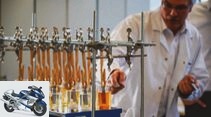
17th pictures
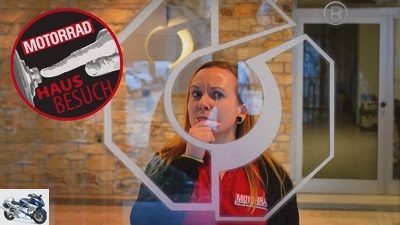
Tobias Beyl
1/17
The MOTORRAD home visit is entering the first round.
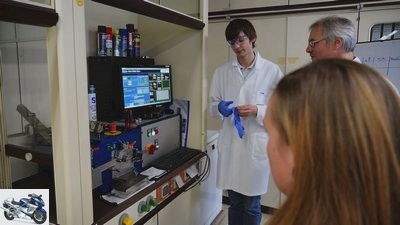
Tobias Beyl
2/17
The wear of the test body – wetted with chain spray – is measured on a special machine.
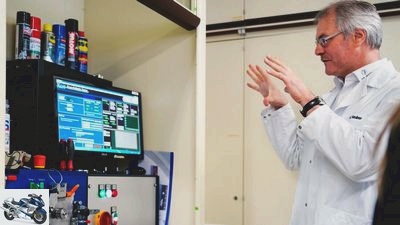
Tobias Beyl
3/17
Hartmut Hauber, Head of Application Technology, explains the equipment.
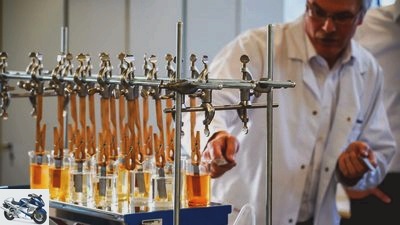
Tobias Beyl
4/17
The test setup for measuring the corrosion protection.
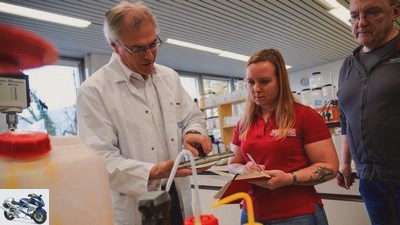
Tobias Beyl
5/17
Hartmut Hauber shows here how the agent is applied to the test plate.
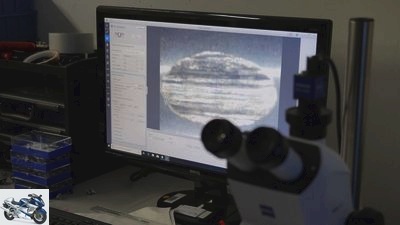
Tobias Beyl
6/17
After the wear measurement, the point is measured under the microscope. Here is a not very effective product.
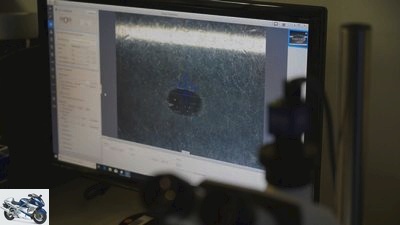
Tobias Beyl
7/17
The white chain spray brought out this little spot. Significantly smaller than the test product before.
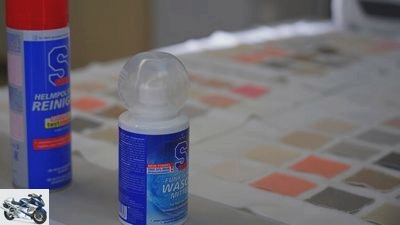
Tobias Beyl
8/17
Textile detergents are also tested with different types of stain.
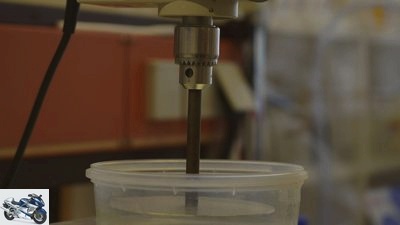
Tobias Beyl
9/17
Here is the setup for testing the throwing-off behavior.
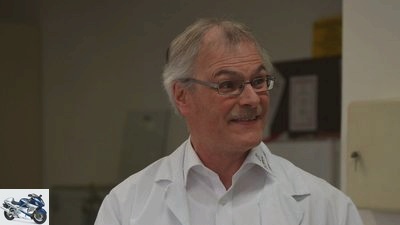
Tobias Beyl
10/17
Hartmut Hauber is Head of Application Technology at Dr. OK. Wack Chemie GmbH.
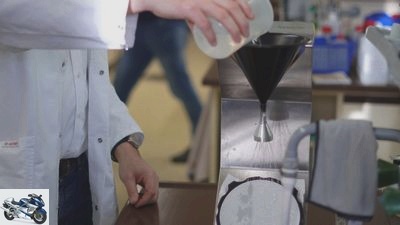
Tobias Beyl
11/17
Here is the test setup for impregnation spray.
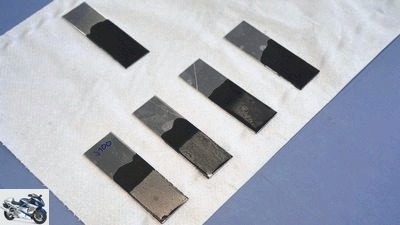
Tobias Beyl
12/17
There is even artificial dirt. This is how the cleaning effect is measured.
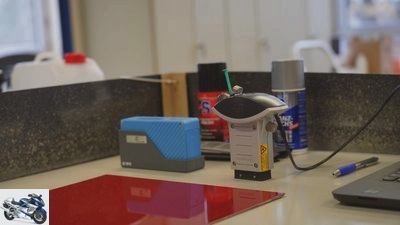
Tobias Beyl
13/17
This is about the effect of polish and wax.
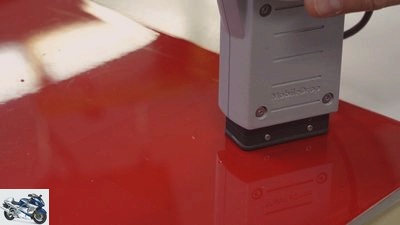
Tobias Beyl
14/17
A contact angle measuring device places tiny drops of water on the surface and measures the angle that is created by the edge of the drop.
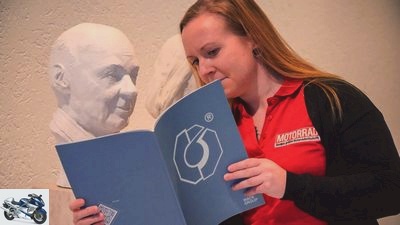
Tobias Beyl
15/17
Dr. OK. Wack himself is still often on the road in the company. And if he is not there in person, then his image in the auditorium.
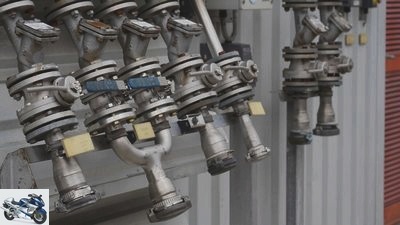
Tobias Beyl
16/17
This is where the lines to which the raw materials are delivered are located.
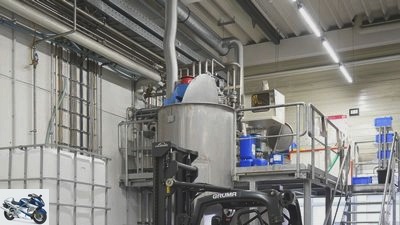
Tobias Beyl
17/17
One of the many mixing stations in the production.
counselor
MOTORRAD home visit Dr. Wack: In the S100 test laboratory
MOTORRAD home visit Dr. Wack
A look into the S100 test laboratory
The MOTORRAD home visit gives you a glimpse behind the scenes of companies in the motorcycle industry. This time we are for you in the laboratories of Dr. Wack and show the procedures with which the care line S100 is tested.
Mona Pekarek
11/29/2019
Dr. Wack is one of the leading manufacturers of products for vehicle care. 1975 by Dr. Founded by Oskar K. Wack, the Ingolstadt company is still in family hands. The products in the motorcycle sector are carried under the sub-brand S100, best known for the motorcycle cleaner, as well as the white chain spray and the transparent Dry Lube.
Company foundation: 1975
Employees worldwide: Approx. 300
Managing Director: Dr. Harald Wack, Ralph Hoeckle, Stefan Wind
Corporate headquarters: Ingolstadt
For the MOTORRAD home visit we were allowed to take a look behind the scenes of Dr. Throw it up, take a look around the company’s own laboratories. There, Hartmut Hauber, the head of application technology, regularly checks the quality and effectiveness of the white chain spray, which has often performed well in the MOTORRAD comparison test. We have put together for you which procedures are carried out there and how the various criteria are checked.
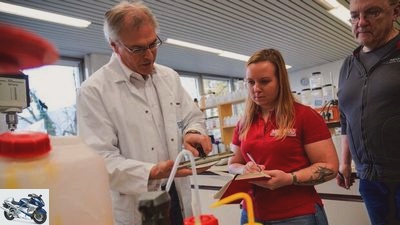
Tobias Beyl
Hartmut Hauber explains the different setups of the tests.
Test procedure for the S100 white chain spray
Dr. With the white chain spray, Wack, or S100, would like to meet four requirements that they themselves place on good chain lubrication: wear protection, creep ability, corrosion protection and adhesion. These properties are regularly tested in the laboratories – we took a closer look at the whole thing.
1. Wear measurement
A test stand from the University of Mannheim simulates the movements of the chain by means of friction on a treated piece of metal, making the wear measurable. To do this, a metal roller in a tub is moistened with the lubricant; after ten minutes of drying time, it hits a small metal cylinder while rotating. In addition, different parameters such as friction and temperature are constantly measured. Depending on the manufacturer – competing products also run over the roller here – a more or less worn area arises on the test body. This furrow is then measured under a microscope. This creates a comparable and reproducible value for wear protection.
2. Corrosion test
For this purpose, degreased metal plates are first treated with the chain spray and dried for one hour. Then they bathe in a five percent saline solution, which is constantly stirred gently. After 24 hours they are finally wiped off and the size of the discolored, attacked area is measured. In this way it can be determined how well an appropriate agent – in this case the white chain spray – protects against corrosion, i.e. rusting of the chain.
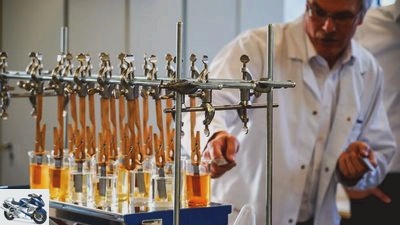
Tobias Beyl
Here is the setup for testing the corrosion protection.
3. Creep behavior
To measure the creep behavior, first two cleaned glass plates are placed on top of one another so that the lower one peeks out a little. The chain spray is sprayed onto this resulting edge. It now begins to crawl between the plates over a period of 15 minutes. The method used to subsequently compare these areas is surprising: a graph paper is placed on top and the edge of the agent that has flowed in is traced. The creep behavior can now be measured and evaluated depending on the area.
4. Liability
The adhesion concerns on the one hand the dirt adhesion and also the throwing off of the agent from the chain. The latter is measured by spreading the agent evenly on a round metal plate and then rotating it. Around it is a collecting container that is weighed before and after. In this way, the mass of the agent that was thrown off can be determined.
The adhesion of dirt is also assessed using a scale. A metal plate is treated with the spray and positioned upright to dry and run off. It is then pressed into a bowl of sand that is on a scale. If grains of sand stick to the piece of metal, the difference in the weight of sand in the container can be used to determine the amount of dirt that has stuck.
Further test procedures for S100 products
1. Impregnation spray
To measure the effectiveness of the impregnation spray, half of a cleaned cloth is treated with the agent. After an hour of drying time, water is poured over it. It quickly becomes apparent that the untreated side is completely soaked with water. In the best case scenario, water rolls off the treated side completely. After one run, the visible water residues are rated using a scale with comparative images. If necessary, the sprinkling is repeated up to ten times, with an evaluation being made after each sprinkling.
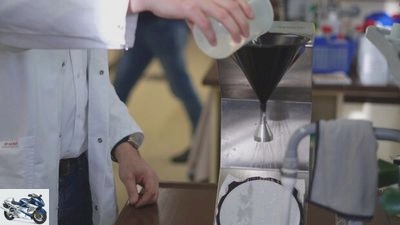
Tobias Beyl
This is how an impregnation spray is tested: let the agent take effect, clamp in, water.
2. Laundry detergent
The detergent for motorcycle clothing is also regularly tested. For this purpose, squares of fabric with various impurities – for example blood, oil, red wine, everything standardized and bought in this form – are washed with the agent. A measuring device then determines the intensity of the residual discoloration, or more precisely the degree of whiteness of the spots. This means that precise values can also be compared here.
3. Polish and wax
Not everything that shines shines the same. With most polishes you actually see a direct before-and-after difference in the surface. But there is also a measuring device to measure exactly how much the gloss has improved. This measures what is known as the haze of gloss, i.e. the proportion of scattered light in the reflected light, as well as the gloss, which shows how much light is reflected from the surface.
A wax treatment usually aims to visually enhance surfaces and protect them from the effects of the weather. So water should roll off as well as possible. This is measured using a contact angle measuring device. A tiny, defined drop of water drips onto the surface and transfers the image to the computer with an integrated microscope camera. The angle at which the edge of the drop meets the wax-treated surface is now measured. If it is very steep, the water is effectively repelled. If the edge is flat, the effect is less.
Conclusion
Dr. Wack attaches great importance to testing its products intensively and developing them further. The large test laboratories and the noticeable dedication of application engineer Hartmut Hauber clearly showed the great importance that our own recipes have here. Around 30 people are employed in in-house research. No matter what they come up with: We will test it for you.
Related articles
-
Test winner chain cleaner (MOTORRAD 26-2014)
mps studio accesories Test winner chain cleaner (MOTORRAD 26/2014) Test winner chain cleaner (MOTORRAD 26/2014) Dr. Wack S100 chain cleaner power gel The…
-
Test winner cruiser station wagons (MOTORRAD 19-2013)
mps studio clothing Station wagons, jackets & pants Test winner cruiser station wagons (MOTORRAD 19/2013) Test winner cruiser station wagons (MOTORRAD…
-
Test winner high-pressure cleaner (MOTORRAD 1-2014)
mps studio accesories Test winner high-pressure cleaner (MOTORRAD 1/2014) Test winner high-pressure cleaner (MOTORRAD 1/2014) Nilfisk C 110.4X-tra The…
-
Test winner back protectors (MOTORRAD 20-2014)
mps studio clothing Test winner back protectors (MOTORRAD 20/2014) Test winner back protectors (MOTORRAD 20/2014) Ortema Ortho-Max The Ortema Ortho-Max…
-
Test winner multifunctional oils (MOTORRAD 26-2015)
mps studio accesories Test winner multifunctional oils (MOTORRAD 26/2015) Test winner multifunctional oils (MOTORRAD 26/2015) Liqui Moly Multi Spray Plus…
-
Test winner motorcycle locks (MOTORRAD 2-2016)
mps studio accesories Test winner motorcycle locks (MOTORRAD 2/2016) Test winner motorcycle locks (MOTORRAD 2/2016) Burg-Wachter Gamma 700 / GKM 10/150…
-
Test winner enduro tires (MOTORRAD 11-2013)
Jahn accesories tire Test winner enduro tires (MOTORRAD 11/2013) Test winner enduro tires (MOTORRAD 11/2013) Metzeler Tourance Next Jorg Lohse, Karsten…
-
Test winner waterproof sports boots (MOTORRAD 09-2015)
mps studio clothing Boots Test winner waterproof sports boots (MOTORRAD 09/2015) Test winner waterproof sports boots (MOTORRAD 09/2015) Alpinestars S-MX…
-
Test winner sports tires (MOTORRAD 13-2013)
Jahn 23 pictures Jahn 1/23 The 2013 MOTORRAD sports tire test. Jahn 2/23 The sports tires on the country road and motorway. Jahn 3/23 Where did the…
-
Test winner sporty leather jackets (MOTORRAD 16-2015)
mps studio clothing Station wagons, jackets & pants Test winner sporty leather jackets (MOTORRAD 16/2015) Test winner sporty leather jackets (MOTORRAD…